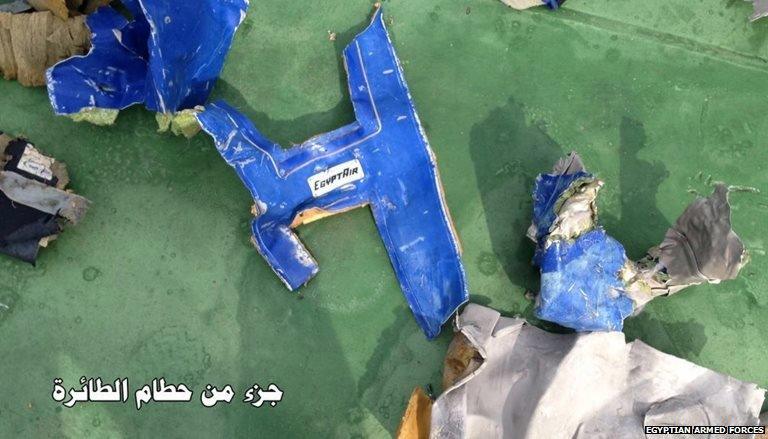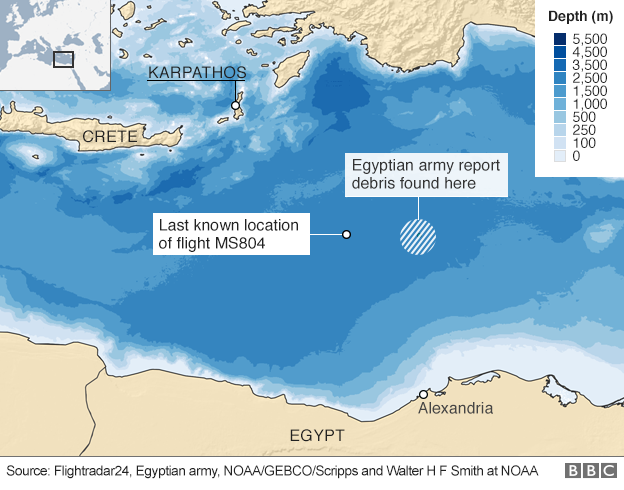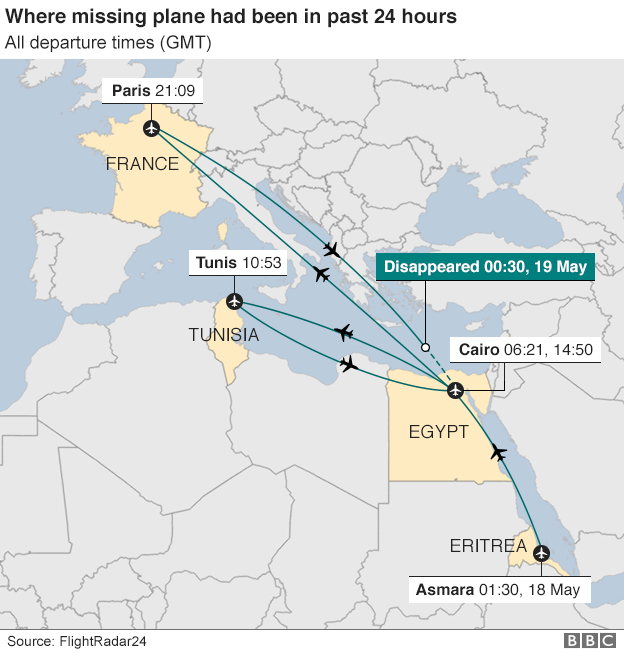EgyptAir flight MS804: What we know
- Published

The EgyptAir Airbus A320 flying overnight from Paris to Cairo crashed into the eastern Mediterranean Sea on 19 May 2016. All 66 passengers and crew on board Flight MS804 died.
Some debris from the crashed flight was later found floating in the Mediterranean, 290km (180 miles) north of the Egyptian city of Alexandria.
French investigators say the crash was probably caused by a fire in the cockpit.

What happened, when?

Flight MS804 left Paris Charles de Gaulle Airport at 21:09 GMT (23:09 Paris time) on Wednesday. It was scheduled to land at Cairo International Airport at 01:15 GMT (03:15 Cairo time).
At 23:24 GMT (02:24 Athens time), the plane entered Greek airspace.
Greek air traffic controllers spoke to the pilot at 23:48 GMT as the plane flew over the island of Kea. He was in good spirits and reported no problems.
At 00:26 GMT smoke was detected in the toilet, according to data sent back to the airline via the ACARS reporting system.
At 00:27 GMT, more smoke was reportedly detected in the avionics area which contains the aircraft's electronics and computers below the cockpit.
The controllers tried to make contact with the plane at 00:27 GMT, before it left Greek airspace, but despite repeated calls, the aircraft did not respond.
At 00:29 GMT, the aircraft left Greek airspace and at 00:29.40 GMT it vanished from Greek radar.
At some point before the aircraft was lost from radar, it turned 90 degrees left and then 360 degrees to the right, dropping from 37,000 [11,300m] to 15,000ft [4,600m] and then 9,800ft [3,000m], according to Greek investigators.
Ehab Azmy, the head of Egypt's state-run provider of air navigation services said the plane did not divert from its course at any point. He also said the crew did not make any calls reporting smoke on board.
The plane lost contact with Egyptian radar at 00:30 GMT (02:30 Cairo time), when it was 280km (174 miles) from the Egyptian coast. Mr Azmy said there were no problems with the plane when it entered Egyptian airspace.
Search and rescue operations began at 00:45 GMT.

How was the wreckage found?

The area in which flight MS804 crashed is one of the deepest in the Mediterranean - more than 3,000m (9,800ft) in some parts.
Days after the search began, debris and body parts were found to the east of the plane's last known location. Egypt's military released images of debris including a lifejacket, pieces of fabric and metal fragments.

The European Space Agency (ESA) said one of its satellites had detected what appeared to be a 2km-long oil slick in the eastern Mediterranean Sea in the same area the plane had disappeared.
On 15 June, Egyptian investigators said the deep sea search vessel John Lethbridge had found wreckage of the fuselage of the plane in "several main locations" and had taken the first images of it and begun preparing a map of the distribution area to help with recovery.
Both the cockpit voice recorder and the flight data recorder were found over the course of the next two days. The data recorder confirmed the presence of smoke on board, while the voice recorder captured conversation in the cockpit about a fire.


Was this an act of terrorism?

Latest findings by French investigators seem to rule out this version.
France's civil aviation accident bureau (BEA) said in July 2018 that "the most likely hypothesis is that a fire broke out in the cockpit while the aeroplane was flying at its cruise altitude and that the fire spread rapidly resulting in the loss of control of the aeroplane".
This contradicts earlier statements by Egyptian officials.
In December 2016, Egypt's aviation ministry announced that traces of explosives had been found on victims' remains.
No group had said it was behind the crash, although Egyptian officials said terrorism was the likeliest cause.
The BEA said it was awaiting Egypt's final report into the crash to understand the differences in their conclusions.
The crash came seven months after an Airbus A321 operated by the Russian airline Metrojet was brought down by a bomb over Egypt's Sinai peninsula, killing all 224 people on board.
A local affiliate of the jihadist militant group Islamic State, called Sinai Province, said it had smuggled a device on board.
In France, the Flight MS804 focus was on a possible breach of security at Paris Charles de Gaulle airport.
After the November 2015 Paris attacks, some airport staff had their security clearance revoked over fears of links to Islamist extremists.
Reports say officers who were on duty at Charles de Gaulle on the evening the EgyptAir plane took off have been interviewed.

Who was on board?

Relatives and friends of those on board gathered at Cairo airport in the immediate aftermath
There were 56 passengers, seven crew members and three security personnel on board.
The passengers comprised 30 Egyptians, 15 French, two Iraqis, one Briton, one Kuwaiti, one Saudi, one Sudanese, one Chadian, one Portuguese, one Belgian, one Algerian and one Canadian. Three of the passengers were children, two of them infants, EgyptAir said.
Egypt's state-run al-Ahram newspaper identified, external the pilot as Captain Mohamed Shokeir. He had 6,275 hours of flying experience, including 2,101 hours on the A320, EgyptAir says, while the first officer, Mohamed Assem, had 2,766 hours.
There were no known names on current terrorism watch lists, according to European security officials quoted by the Associated Press news agency.

What do we know about the plane itself?

Airbus said, external the aircraft involved, an A320-232 registered as SU-GCC, was delivered to EgyptAir from the production line in November 2003.
The twin-engine aircraft had accumulated approximately 48,000 flight hours.
The plane-tracking website, Flightradar24, reported, external that on 18 May, the day before the crash, that the plane had flown from Asmara in Eritrea to Cairo, then on to Tunis before heading, via Cairo, to Paris.
The BBC has learned that the A320-232 was forced to make an emergency landing in 2013 after the pilot noticed the engine overheating but an official report said the defect had been repaired.
A320s, external typically seat 150 passengers in a two-class cabin, or up to 180 in a high-density layout. They have a range of up to 6,480km (3,500 nautical miles).
The aircraft family first entered service in 1988. At the end of April 2016, more than 6,700 A320s were in operation worldwide, according to Airbus. To date, the entire fleet has accumulated almost 180 million flight hours in over 98 million flights.